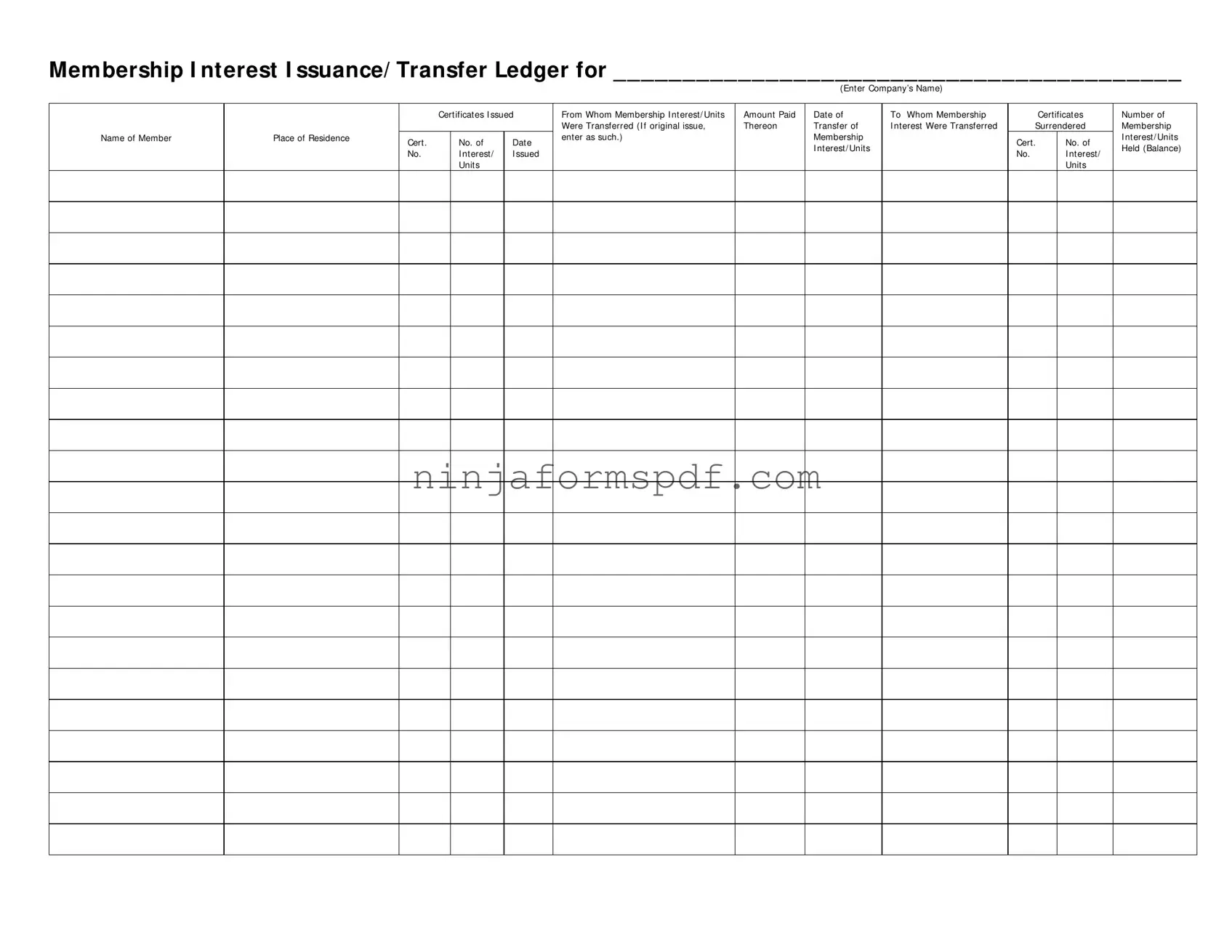The Corporate Stock Ledger shares similarities with a Membership Ledger in many aspects. Both documents are vital for tracking ownership within a company, whether in the form of stock shares or membership interests. They meticulously record issuances, transfers, and the current holdings of each member or stockholder, including details such as the certificate numbers, the amount paid, and the balance of ownership held. The crucial difference lies in their application to different types of business entities: stock ledgers for corporations and membership ledgers for LLCs or similar organizations.
Similar to the Membership Ledger, the Transfer Ledger is essential in documenting the change of ownership over a specific asset, often seen in companies or organizations with transferable interests or shares. This ledger details the transaction from one party to another, including dates, parties involved, and the quantities transferred. While the Transfer Ledger can apply more broadly to various assets, the Membership Ledger specifically tracks membership interest transactions within a company.
Another document akin to the Membership Ledger is the Capital Contributions Ledger. This document focuses on the financial investments or contributions made by members to the company. It records the amount contributed, the contributor, and the date of contribution. Though primarily focused on capital input rather than transfers or issuances, it is crucial for understanding each member's financial stake and contributions to the entity's capital, complementing the ownership and transfer information found in a Membership Ledger.
The Share Register operates similarly to the Membership Ledger but is tailored for corporations that issue shares. It keeps records of each shareholder's name, the number of shares owned, the share certificate numbers, and any transfers of shares between parties. Like the Membership Ledger, it serves as an official record of who owns what part of the company, ensuring clear ownership tracking vital for governance and financial transactions.
The Unit Ledger bears resemblance to the Membership Ledger, especially in organizations that use unit-based ownership such as certain LLCs or cooperative entities. It tracks the distribution, transfer, and current ownership of units, akin to shares or membership interests. Each entry details the unit holder, the number of units owned, any changes in ownership, and the current balance, ensuring transparent and current information on each member's stake in the entity.
Similar in function to the Membership Ledger, the Beneficial Ownership Register records details about individuals who ultimately own or control a legal entity. This document includes names, addresses, and the extent of ownership or control. While the Membership Ledger is more focused on the transactional aspect of membership interest, the Beneficial Ownership Register aims at identifying the natural persons behind the legal entities, enhancing transparency and compliance with regulatory requirements.
The Member Contribution and Distribution Ledger resembles the Membership Ledger but focuses on tracking the financial distributions to and contributions from members of an entity. It provides detailed accounts of the monetary transactions between the company and its members, such as dividends or capital distributions, alongside contributions. Although it doesn't document membership interest transfers, it's integral to understanding the financial engagement of members with the entity.
The Voting Rights Ledger is analogous to the Membership Ledger in that it records aspects of ownership that confer specific rights, particularly voting rights within an organization. This ledger details each member's voting power, often based on their ownership stake or membership interest. While the Membership Ledger provides a broader view of ownership, the Voting Rights Ledger zeroes in on the implications of that ownership on governance and decision-making processes.
The Asset Register, while not focused solely on membership interests, serves a parallel purpose in cataloging the details of a company's assets. This includes the acquisition date, cost, and subsequent transfers or disposals of assets, akin to how the Membership Ledger tracks the issuance, transfer, and current holding of membership interests. Both are crucial for accurate record-keeping and financial management within an organization.
Lastly, the Debenture Register is akin to the Membership Ledger as it is used by companies to keep track of debenture holders (creditors) and their interests. It records details such as the amount loaned by the debenture holder, the issuance date, and any repayments or transfers of the debenture. Although focused on debt rather than equity, like the Membership Ledger, it ensures that all financial interests in the company are meticulously documented and managed.

